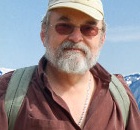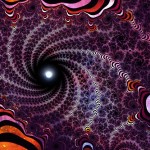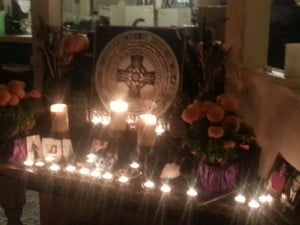I have been over my head in a scholarly writing project, and my blog posts have suffered. However, the paper I am working on melds matters metaphysical with contemporary political phenomena, even though I will not go explicitly into the metaphysics there. But the metaphysical issues are important, maybe very much so. It dawned on me that an earlier blog post I’d made had set the stage for that discussion of politics and metaphysics. Further, a mostly Pagan audience is more receptive to the reality of the power of thought disengaged from bodies than an audience at a typical academic conference.
Accordingly, this post is the first part of a discussion of politics and metaphysics, and it concerns the reality of thought forms that are not the deliberate creation of magickal workings. (A version of it appeared on BeliefNet. Because of a vicious attack on our religion and their high handed response when I objected, I left them. My posts there, many of them anyway, are now unfortunately unavailable.) What the thought forms of Darth Vader and Luke Skywalker have to do with contemporary American politics might seem pretty far removed from our day-to-day reality. The second post will suggest otherwise.
But first the story as to why I take such outlandish concepts seriously.
I was party to an amazing series of incidents that took place during the 1980s. I was a complete newbie in matters Pagan and occult at the time, more an amazed bystander who knew, and still knows, a number of the people involved rather than a participant. My friend Don Frew was centrally involved, and so I recently visited him to refresh my memory about the details of events that happened over 20 years ago. These events constitute one of the most fascinating explorations into the reality of Thought Forms that I have ever encountered, and have significance, I believe, for what our world is experiencing today.
The story begins with a Ouija board. A group of friends had gathered to play with one, and a woman who I will refer to as “Lark” was among them. She thought Ouija boards were kind of silly, but her friends wanted to play, so she went along. There were many fans of Battlestar Galactica in the group, and they decided to see if they could contact a character in the TV series. Lark ended up being on one end of the planchette and was about to discover hitherto unsuspected and not entirely welcome abilities.
The Battlestar Galactica characters came through quite strongly, to everyone’s amazement. But soon afterwards, Lark began experiencing powerful urges to write on some paper. As she did, the character came through again, but more rapidly. Lark had never been a serious fan of Battlestar Galactica, preferring Star Wars, the first episode of which had recently come out. Perhaps because of her much stronger emotional involvement with Star Wars, two major characters from that movie began communicating through her pen: Luke Skywalker and Darth Vader.
The two appeared to be contesting with one another for control of her pen as they had contested with one another in the movie. Episodes of autonomic or automatic writing got more frequent and more difficult for Lark to resist. The battles between the two characters for domination over her writing began to dominate her life, and both claimed that “Star Wars” was an actual historical event that happened “A long time ago in a galaxy far, far away….” Lucas had supposedly psychically picked up on what had happened, turning it into a movie. Lark, in an earlier incarnation, had supposedly been a female cat-like alien who had been Skywalker’s lover and once Vader’s student. This being had also started influencing Lark’s life, and she would go into trance with it. Vader wanted her backing his camp, and in one case even knocked her forward out of a chair, causing a serious welt to appear across her back as “discipline.” Frew remembers him writing that this was a reminder “of what a light saber feels like.”
Whatever was happening, it was getting out of hand, and Lark was not happy about it.
Psychic space aliens?
Around this time these events came to the attention of J. Allen Hynek, the noted UFO researcher and adviser to the US Air Force on such matters. At the time, Hynek had become interested in people claiming psychic connections with aliens, and he had devised a interesting means to make an initial evaluation. If person A was claiming such connections, he would ask person B, who also claimed alien connections, about the characteristics of the alien supposedly contacting person A, who was unknown to B. The person/alien he asked about Lark’s alien described her as a cat-like female.
As Hynek studied what was going on with Lark, he decided it was too weird for his purposes and backed out. However, he suggested she work with Don Frew, who at the time was deeply involved in investigating paranormal phenomena in the San Francisco Bay area.
Frew remembers that Lark’s episodes of writing were so rapid that someone had to tear the paper on a pad away so she could continue on a fresh sheet, and that while always very hurried, the handwriting styles of Vader and Skywalker were different. On the other hand, the female alien spoke through Lark rather than writing.
It seemed pretty clear to Frew that whatever was happening, Star Wars was not a genuine historical event. His guess was that Vader and Skywalker were thought forms, creations of the mental focus of many people on a particular character that coalesced into a kind of psychic entity ‘fed’ by mental attention. Thought forms had a long history in Western and Tibetan magickal traditions at least, but they had always been considered deliberate constructions by a magician. If Vader and Skywalker were thought forms, then thought forms could also be created by the relatively undisciplined thoughts of thousands or millions of people.
Vader communicates with Vader
Frew had friends in the comic and science fiction communities, which would prove very important in exploring this possibility. Around this time a science fiction convention was held in the Bay Area, and David Prowse, who played Vader’s body (James Earl Jones played his voice) was going to be a guest there. Frew sent Prowse a query asking whether he would be interested in meeting ‘Darth Vader.’ Prowse responded that yes, he would. He, Frew, and Lark met, she went into trance, and Prowse talked with Vader.
The result of the meeting was deeply disturbing to Prowse. He told Frew that Vader told him things about the character that Prowse had come up with to help give his acting depth, but which no one else knew. Vader even described details about the interior of Prowse’s home in England. It was like talking to the ‘real’ Vader himself, Prowse told Frew.
Prowse’s experience was compatible with the possibility of Vader being a thought form. He knew information that people involved with Vader knew, but he did not know how a light saber worked because no one did. But Frew wanted to explore this possibility further. If this was the case, Lark was (in his words) a “literary medium,” a medium who could communicate with thought forms created by popular attention.
But how to test this possibility? Frew’s first effort was to see whether Lark could contact Spiderman, a comic book character with tens of thousands of devoted fans. She could. ‘Spidey’ came through loud and clear, and gave some information about the character not known to the general public. But there was no way to test whether this information was valid or not. Spiderman was the creation of several people.
Grimjack weirds out his creator
It was then that Frew thought of testing this possibility with “Grimjack,” a popular character then, but largely unknown today. The character was essentially the creation of two men, Tim Truman and John Ostrander. No one else was involved in the writing. He has some 40,000 fans. One of the two men (Frew thinks it was Truman) was going to be in Berkeley staying with a mutual friend.
A meeting was arranged, and Lark was encouraged to contact Grimjack. When the character came through, he was asked a number of questions about future adventures. Truman was then told what Grimjack said and was, in Frew’s words, “weirded out.” The information was accurate, but there was no way Lark could have known it.
I never met either Skywalker or Vader, nor did I meet Hynek, Prowse, or Truman. I personally knew all the other parties, and was present when they were discussing what was happening. I was also present when Lark channeled the female alien and was finally freed from her unpleasant connection with the Star Wars entities. She was asked to have the alien come through. After some conversation with Greg, a shaman, the entity was tricked into entering a crystal. Greg immediately encased the crystal in salt and a jar, and buried in a place where it was unlikely to be found.
Lark had no more trouble.
I showed an earlier version of this account to Greg and he added the following comments about his final freeing of Lark from her tormentors. It is also a fascinating account of the experience of shamanic healing.
Here is what I remember Don sat over there, my anchor Lark went into a trance, and so did I
She verbalizing, me asking questions and sometimes directing attention
Like most trance journeys, details are blurred (esp after so many years) but first I just followed here a bit to see where she was, and then to see the entities of her dreams
In light of your thought forms—without her projection the experience was through my own, so that the “dimensions” or whatever she called them were less detailed with the SF/movie and familiar to me in my terms.
The closest we got to Darth Vader was close enough for me. The Whirlpool, the Pit, the hole into the void—it’s those to me—the great desire, the lust for emptiness, the place of falling into when despair is the best we can do. It looked like Darth Vader to me that moment.
At the bottom of that endless pit is where an owing takes place, can take place, and lies the spark. I remember Lark owning it, the skeleton mother devours Inanna, and I asked her where did he live in her and she said her heart.
And where now Lark, is Obi Wan Kenobi? Pause. He must be here. *gasp* Ask him, Lark, if you wish, to help you
“That’s too corny,” she says out loud—it’s an iconic scene in the movie after all.
No, no, don’t get distracted, where is Obi, don’t speak out loud, use your hands, see use the feathers here to show the path a bit, and she asks and I see this ball of golden light there, and it comes and pauses, and just reach out and take it and it’s ok? Yes? Where will you put it? Him? Yes, of course. Welcome him, ok, thank him, ok!
And for Darth, the shadow, do you want to keep him there or throw him away? And then was the crystal and bottle.
Significantly to me, a traditional shamanic method succeeded in ending unpleasant experiences with thought forms, apparently by breaking off the central connection.
As to who or what the female alien was, no one seems quite certain. She could not have been a thought form in the same sense Vader and Skywalker were because she was not a character in the movie. On the other hand, there were extensive secondary stories being produced based on the movie’s plot, and Lark herself, after the alien’s contact, began writing some.
Obviously playing a central role between Vader and Skywalker would have some appeal, and the alien could have been her own creation as a literary thought form. Many fiction authors report that their characters take on a kind of independent personality as they are being written, and the Philip experiment (see below) supports this possibility. Yet Vader and Skywalker treated this being as if she were real, and Vader at least had access to knowledge Lark did not.
On the other hand, neither character had any knowledge that was not known by fans. As mentioned, neither knew anything about how a light saber worked, I imagine because no one does. It was a prop. Nor was there any evidence that Vader knew he was Skywalker’s father. As far as I can tell, Lucas had made that decision, changing an earlier story line that had Vader killing Skywalker’s father, but none of the fans knew it. That being so, perhaps Lucas’s ideas were drowned out by popular beliefs to the contrary. (By comparison, no one had any beliefs about Prowse’s house except Prowse.)
It turns out this is not an entirely isolated event. Frew’s investigations are not the only ones that shed some light on this kind of thought form.
A Second Example: The Philip Experiment
The Philip Experiment was conducted by Canadian researchers in the Toronto Society for Psychical Research during the 1970s. Essentially, a thought form was deliberately created and then tested through séances. A short description of the experiment and its context in the history of investigations of the paranormal is Scott Fowler’s The Philip Experiment (short PDF). Iris Owen and Margaret Sparrow wrote a book about this experiment, Conjuring Up Philip: An Adventure in Psychokinesis, which unfortunately is out of print (used copies begin at around $60).
These accounts suggest the boundaries between minds are far more porous than we are inclined to believe, and the creative power of imagination is far greater than we usually think. However, it seems clear that an open-ended variety of psychic manifestations may be of this character. I do not believe the Gods as I have encountered them are the thought forms of human beings, because they were in my experience super-human. (Sometimes I think we might be the thought-forms of the Gods — but that is an entirely different issue.)
The question I will leave this post with, and return to, is: What kinds of thought forms could be created by cultures and ways of life?











